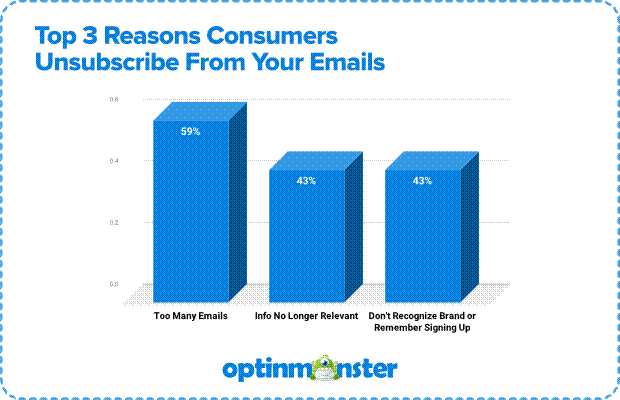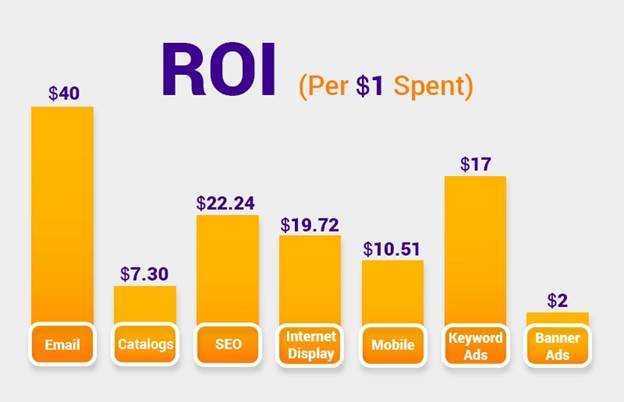Eight Unique and Clever Ways to Use Email Marketing
That You May Not Have Thought Of
Email marketing is one of the original forms of digital marketing, right up there with blinking text and banner ads. Social media platforms and funnel strategies come and go, but email marketing is as reliable as the sun.
But a simple search for “email marketing” returns hundreds of pages promising the same few tips. Below are some ideas that you probably haven’t heard from every other source.
1) Focus on a Single Point
Most marketers load their emails with way too much information for the average person to process. Most people receive over 100 emails every single day and send 40 emails themselves. That’s an incredible amount of information to sift through. And when you factor in that the average attention span per email is only between 10-15 seconds, as a marketer you realize you need to make your point in a hurry.
Instead of writing a full newsletter with several different articles, aim to make your articles “skimmable.” That doesn’t necessarily mean shorter; it just means that you construct your emails so that people can get the major points in as short a time as possible.
How do you do that? Headlines. Lists. Graphics. Charts. And calls-to-action front and center. And be sure to use graphics with your calls-to-action, or slide them into the P.S. section of the email. Colorful graphics are much easier to see quickly, and can be fun for users to click on.
If at all possible, try for one major point in your email to stand out in the crowd – just one. It’s much better for your audience to take action on a single point rather than get frustrated because you gave them far too much to think about.
2) Use Gifs and Animated Gifs
A lot of marketers will tell you that video works great in email, and it does. Hi-resolution images can also work great too.
But an even simpler idea is to use a Gif image, or an animated Gif.
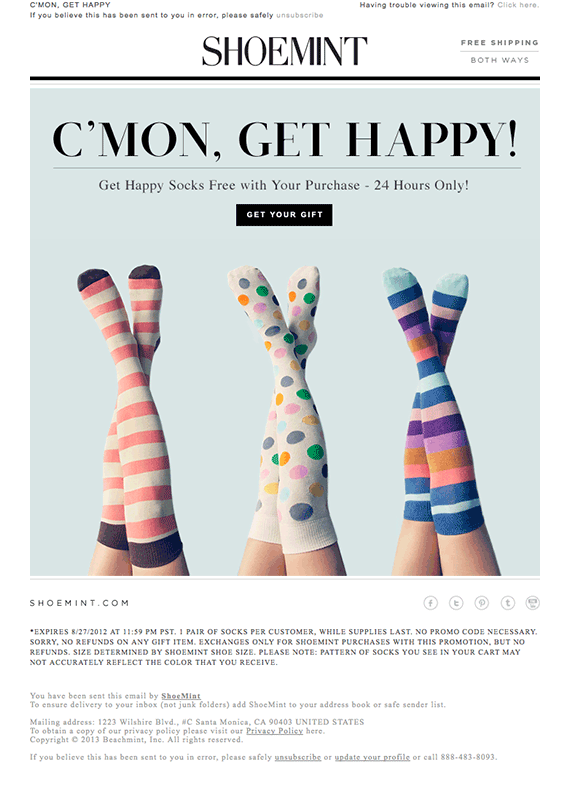
If you want to achieve the benefit of a video but the technical convenience of an image, implement animated gifs inside your email content. These can either be silly gifs that are simply eye-catching or even super short product demonstrations. As always, it’s best to test which kind resonates with your audience.
Gifs have been proven to increase your click-through rate and revenue, but they can also be annoying if overdone. Use them sparingly, but use them nonetheless.
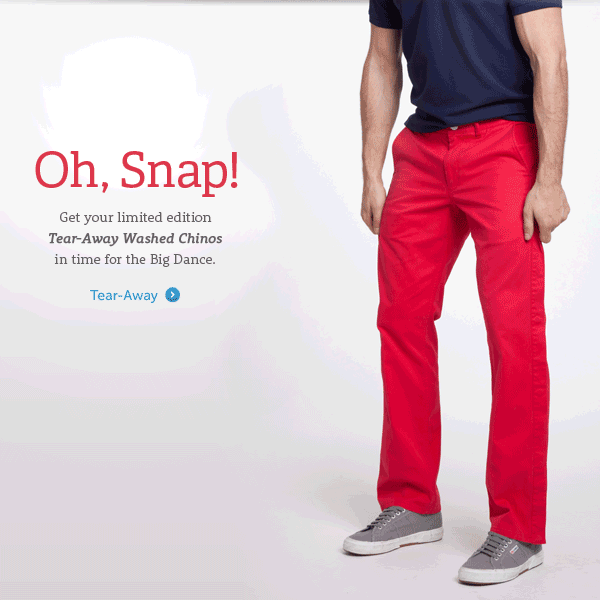
3) Use Emojis in Subject Lines for B2C Email
Really? This one falls into the “take it or leave it” category. Your audience – and your brand – will dictate whether or not emojis are appropriate. If you’re in a fun B2C niche that targets younger readers, give them a try.
Emojis work because they attract the eye. In a sea of really boring plain-text subject lines, a tiny little whimsical image can cause your customer to notice your email amongst all the others. While you won’t want to use them for every email, they work really well for sales emails or promotional campaigns.
Just make sure not to stick too many of them in a single subject line. Google and other internet service providers (ISPs) will probably send them straight to your customers’ spam folders.
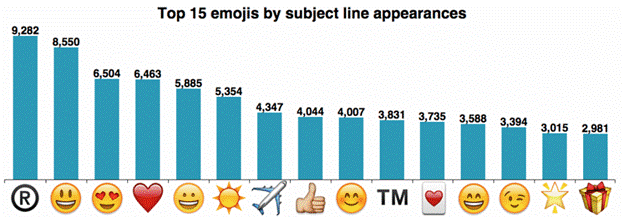
(Image from List Engage)
4) Send Specialty Emails
Almost everyone enjoys getting something free, especially on their birthday, even if that’s just a coupon, a special offer, or an acknowledgment of what day it is.
Even if your email service doesn’t record birthdays as part of your user data, you can still automate an anniversary email to be sent out one year after they sign up. This combination of recognition plus an offer may be enough incentive for them to make a purchase, even if they weren’t planning to initially.
Another interesting tactic is to send a simple “thank you” email. You can thank them for being on your list, for being true to who they are, or anything in between. The key here is to not include any kind of coupon code or product announcement – just a short and simple thank you note.
Specialty emails are effective because they make your brand look human. They also reinforce the fact that you’re not always trying to sell to them (even if you are). It’s amazing how far a little bit of customer appreciation can go.
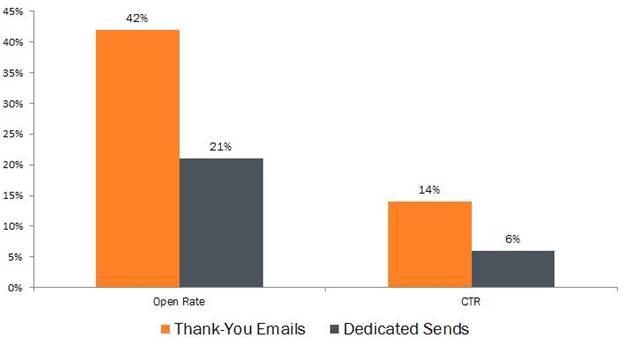
(Image Source) Open Rate and Click Through Rate (CTR)
5) Tell a User Story
User stories are some of the most underrated – yet most effective – forms of content. Not only do you craft a story, which instantly draws people in, but you also highlight the user, making it shareable.
User stories have an amazing ability to make your product relatable. All of a sudden, instead of thinking of your product or service as a generic item, the customer now understands its everyday application. The user’s experience in the story is their experience, in a way.
One company increased its open rate on emails by more than 100% by using stories, while click-through rates increased by over 60%. The social proof that user stories provide give all the validation some customers need to make a purchase, and the extra material helps with your content planning. Social Proof is very important to millennials and Gen Z, as it influences positive reinforcement and conviction when taking action such as buying a product or service.
6) Consider Creating a Curated Newsletter
Curated content is content that has proven to be popular with readers. Think “Best of” or “Greatest Hits”. It’s content on a topic you know will be popular with your readers, if it is relevant to them.
If you’re looking for some help with web site SEO, one of the best things you can do is try to land your website on a link “round-up” section of curated content. These web pages are nothing more than resource pages featuring some of the best material on particular subjects.
You can do the same thing with an email. If you simply want to provide value to your customers, include curated content that you know will be well-received. You can even include affiliate or promotional offers in your email, provided your affiliate program accepts them.
Curated content is super easy to put together and endears you to your audience as a brand that cares about them by not being entirely self-promotional. It’s a win for everyone.
7) Send Unengaged Readers Aggressive Discounts and Offers
Every six months, send your inactive addresses on your email list a short email with your best offer, or never-to-be-repeated discount or premium. You can even hint that if they do not respond, you might take them off your list (although you should not do this) unless they respond to the email in some way.
In some cases, the “inactive” people on your list aren’t really inactive at all. Opens tracking and clickthough tracking are not infallible, and with more privacy regulations every day you simply cannot be sure if someone has not opened, seen and read your email. Reaching out to these unengaged subscribers with a special message can generate good results.
8) Make Your Email “Forward-able”
The number one rule in email marketing is to speak directly to the end-user. That’s why email segmentation is such a big deal; the more specific you can make your email, the better the chance of a conversion.
One way to increase your targeted reach without having a larger email list is by encouraging your users to forward your email to people in their network.
Fortunately, there are a lot of ways for your email to accomplish that. For one, your newsletter provider should have a forward link in your email footer to make it easy to do.
Alternatively, and for better results, you can have a contest where people contribute content and then vote on a winner, thus incentivizing people to publicize their own entry. Breaking news and upcoming events also work well.
It’s perfectly okay to ask people to share your email. If even only a handful of them do, you’ve extended your awareness exponentially.
As the chart below shows, the three most common reasons that people forward your emails are:
- Promotions / Deals / Discounts
- Events
- News and Helpful Content
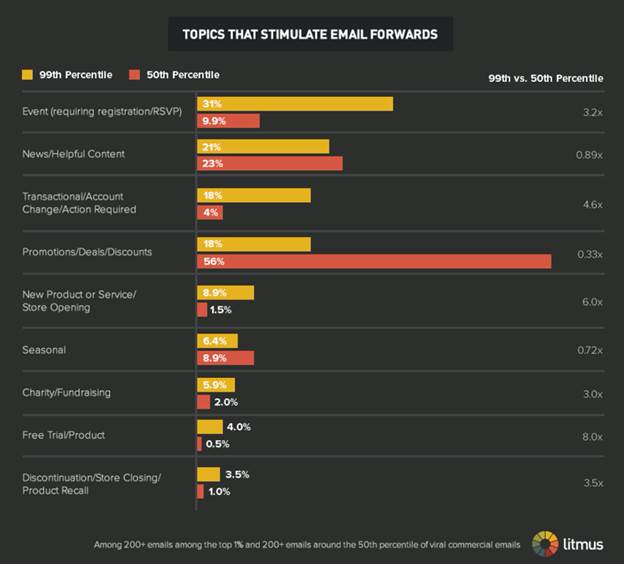
(Image from Jilt Marketing)
Conclusion
Email has managed to stick around because it’s simply unbeatable. With one of the highest returns on investment (ROIs) of any form of marketing, email marketing needs to be a part of your overall strategy. (see chart)
To make email marketing work for you and your situation we recommend being innovative, simple, unique and memorable. Long gone are the days of multi-column emails and many, many articles within one email. Who has the time to read that?
Once you establish a solid foundation and have a good rapport with your subscribers, experiment a little to see what works.
With any luck, you’ll hit on some new tactics that nobody else has ever tried. They may not work with every audience, but they only need to work with those on your list.
To gain traction with today’s readers be sure to keep things focused and fun. Write it like you want to read it yourself.



